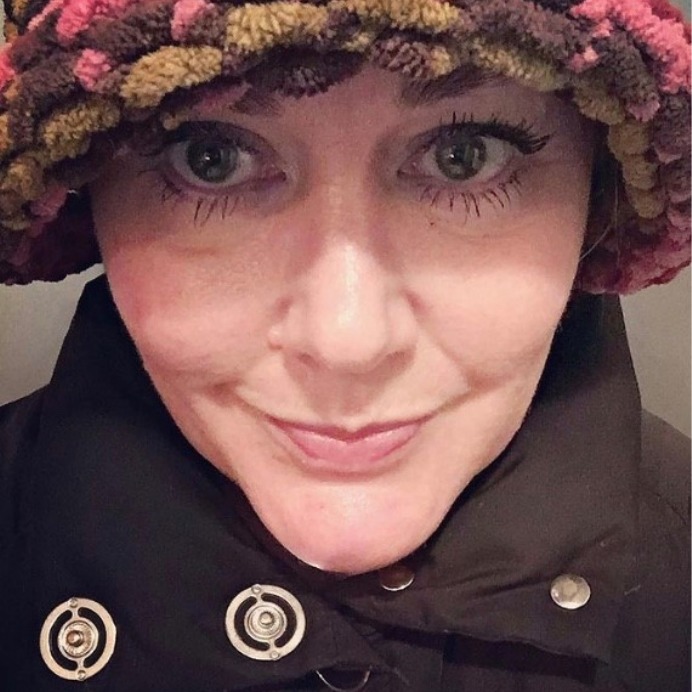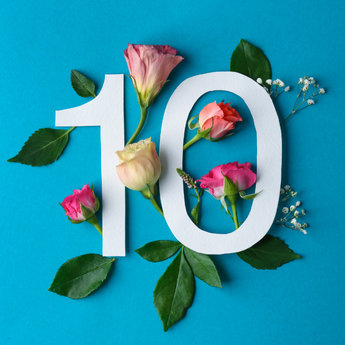 In our monthly column, senior writer and editor Adriana Ermter shares her personal experiences with breast cancer.
In our monthly column, senior writer and editor Adriana Ermter shares her personal experiences with breast cancer.
By Adriana Ermter
I'm a talker. I like to communicate and sometimes, okay often, I’m an over-sharer. I need to know what’s going on and why and in my version of yin and yang, I believe that because I’m an open book everyone else will be too. Except, not so much.
When I was diagnosed with breast cancer, I was tossed into a sea of medical terminology without a life jacket. Fortunately, I’m a pretty good swimmer. I also ask a lot of questions to get the information I need, plus I know how to research and fact-check credible sources online such as the Canadian Cancer Society and the World Health Organization (no, Wikipedia, social media and YouTube are not credible sources), so I buoyed through these unchartered waters by learning as much about breast cancer as I could. When I couldn’t find what I was seeking, I politely stalked the holders of said information, which was almost always a member of the medical staff at the clinic, until they coughed it up. As a writer and editor, this process usually works in my favour. Except this time, again, not so much.
Your own research is necessary
Here’s the thing, well, at least the thing from my perspective. The average woman’s breast cancer diagnosis (and mine was no exception), has become such a relatively straightforward procedure with a frequency among women that is far too regular and consistent that doctors and/or oncology teams are unable to provide the hand-holding that the breast cancer patients, myself included, deserve. It’s kind of like the KitKat of cancers, it’s everywhere, easily and randomly acquired and because of its universality, somewhat on the boring side. Based on the Canadian Cancer Society’s 2020 predictive statistics that put breast cancer in first place, owning 25 percent of all new cancer cases in Canadian women, I get it.
My cancer diagnosis and surgery was a dime a dozen. And if you’ve ever sat in the waiting room of any breast cancer clinic or hospital you’ll agree. Every seat is filled. Often, there’s a line of women standing in their hospital gowns in the hallway and around the perimeter of the room just waiting to sit down. We are many, too many and the medical staff available to support us is spread too thin. The Canadian Cancer Society says 27,400 women will be/have been diagnosed this year, alone. That’s 2,300 new cases a month, which means that 575 women are checking into clinics and hospitals across the country to be tested and diagnosed every week. And that’s only the new cases of breast cancer.
When I was a new case, I remember wondering where the nurse or doctor, you know, the one who is good at talking, explaining, listening and answering questions to help navigate my cancer journey was? It wasn’t the surgeon’s sweeping generalizations after delivering the news, “you have breast cancer” or the nurse who highlighted every single word in a paper pamphlet in yellow ink before pressing it into my hands 20 minutes after I’d been told my diagnosis. And trust me when I say it absolutely wasn’t the teaching doctor, one of four who biopsied the four lesions in my breasts over a series of two weeks, who glared in my direction and scribbled in my medical file before exiting the examination room I was lying in half-naked without a backwards glance or an answer to my questions. In short, there is no person to walk you through the process from start to finish, although I wish there was. Gathering the information you need is up to you.
Reading renowned, credible, health-based websites, like Health Canada and the Mayo Clinic were very empowering to me, because they offer extensive breast cancer information along with easy to understand and helpful Q&A and treatment decision sections. Educating myself about the disease, the different procedures available, in my case a lumpectomy (otherwise known as a partial mastectomy) and so much more made me feel in control in a very out-of-control situation. This type of due diligence is not to be confused with clicking onto WebMD and trying to self-diagnosis, which is terribly difficult to do accurately, but rather reading and learning to gain truthful and fact-based insight into the facts, choices and options available, to provide a sense of calm. If I hadn’t had this and had simply relied on the reading materials and vague generalizations shared by the clinic’s staff, I would have felt ill prepared to join in the conversation about my body. And that lack of knowledge paired with blind trust, in my opinion, is too much for anyone.
Breathing isn’t everything
What isn’t too much and is actually right on point, is the feeling of wanting to throat punch everyone who tells you to breathe. I’m not sure when the stay-calm-and-carry-on catchphrase became so popular, but telling a new cancer patient to breathe, as though this will magically make everything easier feels condescending. I loathed it. Yes, deep breathing is calming and grounding, but I was never hysterical, out of control or unreasonable. I never yelled at anyone, spoke harshly or broke down sobbing, although it may have been cathartic if I had. I was smart, prepared, level-headed, proactive and curious throughout. It doesn’t mean I wasn’t overwhelmed though. Not by the medical jargon, that’s just words and there are dictionaries and once you look up what you don’t understand the language part is super easy. I was overwhelmed by the emotional weight of it all.
Ironically, for someone who likes to be an open book, since my divorce I’ve become choosy about who I show the depth of my vulnerability to. Being single and divorced, I don’t have a built-in security blanket any more. And the friend I typically turn to with my deepest emotions was dating, distracted and unavailable, which was understandable, but still hurt. Yet, it also forced me to accept the help of my inner circle and let them into my journey. This sounds simple enough, but for me it wasn’t. I knew I had built a few walls after my divorce, I just hadn’t realized how high they were. Letting my three closest friends in and sharing my fears and unanswered questions with them was a huge release for me as they gave me a sounding board and fresh perspective. I still went to almost every doctor’s appointment alone. Pre-lumpectomy surgery, my appointments were practically daily and I didn’t feel it was fair to ask someone to constantly take time off work to accompany me, plus none of my friends could have accompanied me into the examination rooms where I would have wanted and needed them most.
So I used them to talk through my medical updates instead. Having someone, besides me, to review the questions I wanted answers to and to share their point of view with me was invaluable. It’s amazing how your circle steps up when you ask them to. My sister Alida made the decision to be with me for my surgery and aftercare by telling me she’d booked a flight from Calgary. I would have never asked her to do this and somehow she knew that, didn’t wait for an invitation and just took the lead. If I’d known then how helpful and necessary this level of support would be, I would have asked. But I didn’t know, so I didn’t ask. I’m forever grateful to Alida for leaving her family for a week to take charge of my situation. I needed someone and not a pop-by, but rather someone to stay in my home, cook my meals, give me my medication at the right time, feed my cat Trixie, boss me around, tell me when to nap, when to eat and when to go back to bed. I live alone, so I assumed I’d be okay healing from surgery alone, but now I know that going solo is too isolating and that this way is so much better.
You can never have too many naked-boobs selfies
Having a soft bra to sleep in also makes breast cancer lumpectomy surgery better. This fact is highlighted in yellow in one of the many pamphlets I acquired in the early days. But it’s noted as a bullet-point suggestion tucked in between other vague recommendations, so I never paid it any attention until a friend in my larger friend circle, who had undergone breast cancer a few years earlier, talked to me about it.
Shopping for an underwire-free, cotton bra was not a positive experience though. I don’t know why this was so emotionally charged for me. Maybe it was because I’d crammed the shopping trip into my lunch hour and was trying to get it done and off my to-do list quickly so that I could move on to the next thing, I’m not sure. The depressing bra options didn’t help either nor did the other women shopping in the store. Like the waiting room at the clinic, these women were at least 10 years older than me, making me feel like my body had betrayed me. Perusing the shitty bra section compounded these negative thoughts, complete with the feeling that I’d be single for the rest of my life. I mean, come on, who wants to date a divorced woman in her forties with a mangled right boob? I’m not saying this was rational thinking, but it’s what I thought.
Pre-breast cancer diagnosis, I only had positive thoughts about my boobs. They were perky B-cups, sat upright, looked good in everything and yet, didn’t cause so much commotion that I felt compelled to take extra measures to cover them up in public. So when I was in the change room trying on the sad-looking bras, I took advantage of the full-length mirror and despite having bandages on both breasts courtesy of the biopsies I’d had the day before, took photos of them naked. I wanted to remember them as they were, how they looked and to capture the pride I’d once had in my boobs, my body.
It’s funny how knowing that part of my breast was going to be removed challenged my sense of femininity. Rationally, I know this is crazy self-talk and I still struggle with the way my body, my right breast, looks now. Having my naked-boobs selfies though, infuses me with strength, so when I start spiraling into a place of negative self-imaging I pull up these pictures, look at them and smile. They are a reminder of who I was and of who I have become.
Adriana Ermter is a multi award-winning writer and editor. Her work can be read in Figure Skater Fitness and IN Magazine, as well as online at 29Secrets.com, RethinkBreastCancer.ca, Popsugar.com and AmongMen.com. The former Beauty Director for FASHION and Editor-in-Chief for Salon and Childview magazines lives in Toronto with her very spoiled cat, Trixie-Belle. You can follow Adriana on Instagram @AdrianaErmter






